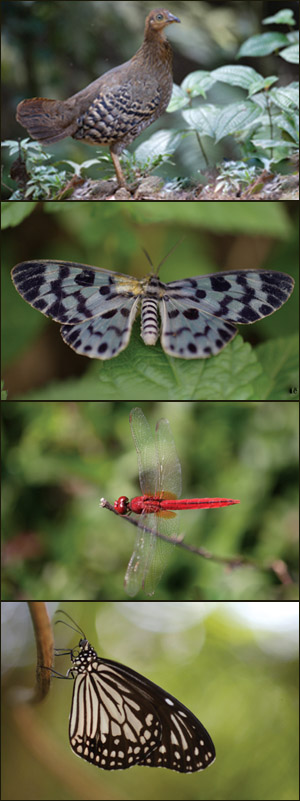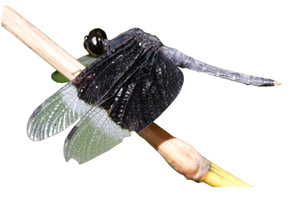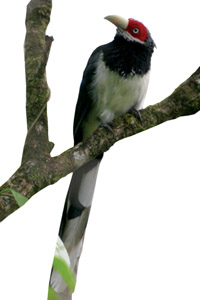Wonders of nature
Trekking Tholangama wetland
By Nilma DOLE
[email protected]
  As we walk silently across the marshy fields of the Thalangama
Wetland, through our binoculars, we spot the Indian Paradise-Flycatcher
bird flying into Sri Lanka from the snowy mountains of the Himalayas. As we walk silently across the marshy fields of the Thalangama
Wetland, through our binoculars, we spot the Indian Paradise-Flycatcher
bird flying into Sri Lanka from the snowy mountains of the Himalayas.
Walking down the muddy track, we hear the soft calling of the spotted
doves along with the common moor hens as they feed peacefully in the
marshes. Coming all the way from the Netherlands to delve in a bit of
Sri Lankan nature adventure, naturalist K. D. Dijkstra said that if
we’re lucky, we can spot a sniper which is a rare sight. Cattle egrets
and purple herons also fish here and several dragonflies and butterflies
can be seen fluttering by.
When dusk descends, the night herons fly above us in flocks and if
you’re lucky, you can see Sri Lanka’s smallest fruit bat flying from its
cave to feed.
One of nature’s best wonders is located at Thalangama which is just a
stone’s throw from Colombo. The Thalangama Wetland makes its home close
to the historically significant Thalangama Tank that was built during
the era of King Parakramabahu VI (1551-1547 AD).
Being the only environmentally friendly area close to Colombo,
Thalangama is not only historically significant, but without its
presence, the Parliament of Sri Lanka is sure to sink.
However, development and urbanisation is seen as a potential threat
because it is surrounded by densely populated human settlements from the
Colombo District. The site is situated in the Madiwela catchment area
within the Kelani river basin which includes the Colombo flood detention
area.
Prof. Sarath Kotagama of the Field Ornithology Group Sri Lanka said
that the Thalangama Wetland is an important roosting site for water
birds especially the migratory ones.
“People shouldn’t misuse the location because we see many coming on
trips and littering”, he requested. The professor said that within the
Thalangama wetland, encroachment is also an issue since there is
development at an alarming rate. “We should live harmoniously with
nature otherwise the result will be a concrete jungle”, he warned.

Raja Puswella, Director of ‘Let’s Trek Lanka’ offering Urban Walks to
people absolutely free of charge says that appreciating beauty of the
place is important, but people should know how to preserve and protect
the wetland.
“There are two quarries near the Thalangama Wetland which makes it an
environmental hazard with noise pollution and chemicals being gradually
dumped into the wetland.
“I hope everyone who visits the Thalangama Wetland should keep it
rubbish-free” he said.
Gehan Wijeyeratne de Silva, naturalist and wildlife photographer, who
is CEO of Jetwing Eco-Holidays, is a firm believer that Thalangama is a
good eco destination with lots to offer. However, he agrees that
development should go hand-in-hand with the environment. “I hope that
people who buy property near the Thalangama Wetland realise that they
share their home with other animals as well”, he deserved. He said that
if you need to mark your boundaries, a mesh fence rather than a concrete
wall is better. We shouldn’t chase animals like the endemic western
purple leaf-faced monkey who feed on fruit on trees and build your house
with eco-friendly material so that it doesn’t hamper nature.
Domesticated animals like dogs and cats battle with endemic species
like the loris and purple leaf-faced monkey for food and shelter which
is also a cause of concern.
Another point was that bringing nature enthusiasts here is also a
difficulty when trying to film nature and take sound recordings of the
birds because everyone is trying to build houses.
Other associations that are working tirelessly to see whether the
Thalangama Wetland is getting the protection it deserves is the Overseas
International School who have their ‘Walk for Wetlands’ campaign
annually. They have even catalogued the various species of flora and
fauna at Thalangama so that there is a better understanding of it
especially for the next generation.
With regard to protection of the Wetlands and the environment, the
‘Nilla Pirinu Ratak’ and the ‘Pivithuru Parisarayak’ are programmes set
up by the Central Environmental Authority and the Environment Ministry
to curb the rubbish problems and protect the environment. Enforcing such
rules and regulations are important because we have to preserve the
environment for our future generations. |

